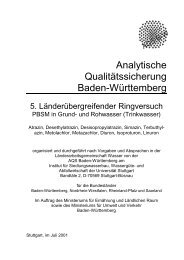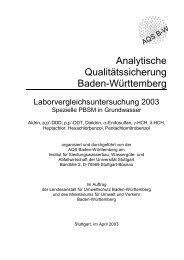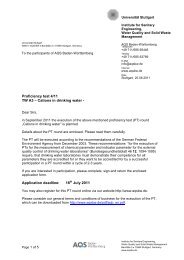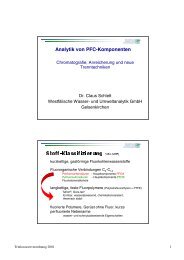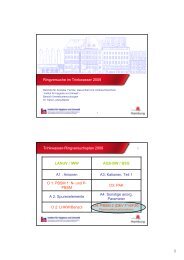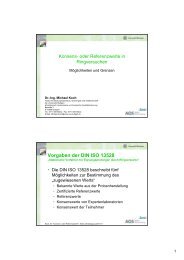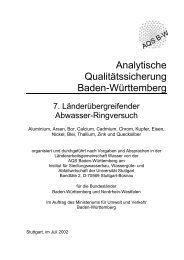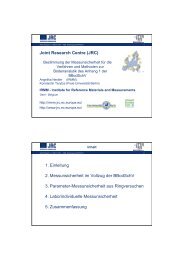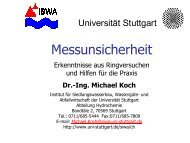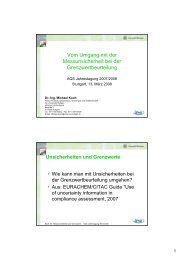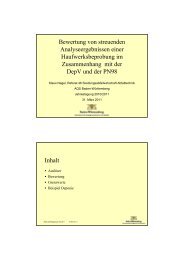Institute for Sanitary Engineering, Water Quality and Solid Waste ...
Institute for Sanitary Engineering, Water Quality and Solid Waste ...
Institute for Sanitary Engineering, Water Quality and Solid Waste ...
You also want an ePaper? Increase the reach of your titles
YUMPU automatically turns print PDFs into web optimized ePapers that Google loves.
<strong>Solid</strong> <strong>Waste</strong> Management SIA<br />
methodologies used in industrialized countries <strong>for</strong> the<br />
characterization <strong>and</strong> quantification of municipal solid<br />
wastes have been taken as a basis, <strong>and</strong> have been<br />
adapted <strong>and</strong> synthesized into a solid waste analysis<br />
procedure appropriate <strong>for</strong> considering the restrictions<br />
<strong>and</strong> local conditions.<br />
Since working conditions during waste collection <strong>and</strong><br />
sorting were not comparable with the European situation,<br />
occupational safety <strong>and</strong> health st<strong>and</strong>ards <strong>for</strong> the<br />
respective activities had to be adapted as well by using<br />
the locally procurable means. Efficient <strong>and</strong> inexpensive<br />
solutions on a low technical level were developed <strong>and</strong><br />
integrated into the solid waste analysis procedure.<br />
As a result of the methodological development <strong>and</strong> validation,<br />
an applicable waste sorting analysis procedure<br />
was achieved, while finding a compromise between<br />
data quality, workers safety <strong>and</strong> health <strong>and</strong> available<br />
resources. Furthermore, since st<strong>and</strong>ard sample survey<br />
techniques have been taken into consideration, sampling<br />
errors <strong>and</strong> uncertainty levels have been accounted<br />
<strong>for</strong>, thus guaranteeing the collection of statistically<br />
representative data.<br />
Financing institution:<br />
Bundesministerium für Bildung und Forschung -<br />
BMBF<br />
Project partner:<br />
Universität Stuttgart, Lehrstuhl für Abfallwirtschaft<br />
und Abluft; Verb<strong>and</strong> zur Förderung angepasster,<br />
sozial- und umweltverträglicher Technologien e.V.<br />
(AT-Verb<strong>and</strong>); Bundesanstalt für Arbeitsschutz und<br />
Arbeitsmedizin (BAUA); Institut für Zukunftsenergiesysteme<br />
(IZES); Environmental Development<br />
Action in the Third World (ENDA); Addis Abeba<br />
Universität, Faculty of Technology; Addis Abeba<br />
Universität, <strong>Institute</strong> of Regional <strong>and</strong> Local Development<br />
Studies; Addis Abeba Environmental Protection<br />
Agency (EPA)<br />
Duration:<br />
June2008 - June 2013;<br />
Project evalution autumn 2010<br />
Contact:<br />
Prof. Dr.-Ing. Martin Kranert<br />
Dipl.-Geogr. Agata Rymkiewicz<br />
M.Sc. Nicolas Escalante<br />
Internet:<br />
www.p-42.de/ignis<br />
Economic <strong>and</strong> environmental evaluation of the<br />
separate collection of recyclable waste from<br />
households.<br />
According to the currently discussed collection systems<br />
in Germany, different scenarios were modelled <strong>for</strong> the<br />
ecological assessment. The priority was to optimize<br />
the collection rate <strong>and</strong> the common collection of nonpackaging<br />
materials. Alternatively, a scenario was modelled<br />
<strong>for</strong> the common collection of residual household<br />
waste <strong>and</strong> lightweight packaging materials with <strong>and</strong><br />
without recycling of the lightweight packaging. As reference,<br />
scenarios are shown <strong>for</strong> urban, <strong>for</strong> densely rural<br />
districts <strong>and</strong> <strong>for</strong> sparsely populated rural districts. For<br />
urban <strong>and</strong> densely rural districts a collection system<br />
<strong>for</strong> light packaging has been modelled; <strong>for</strong> rural areas<br />
a bring-system to recycling-centres was modelled<br />
among others. Thermal waste treatment in waste incineration<br />
plants <strong>and</strong> the pre-treatment in mechanicalbiological<br />
treatment plants (MBT) were considered <strong>for</strong><br />
residual household waste <strong>and</strong> residues from optional<br />
treatments. For the MBT, the utilization of refusederivate<br />
fuel (RDF) in cement plants was modelled.<br />
Relevant process steps <strong>for</strong> collection, processing <strong>and</strong><br />
recycling of lightweight packaging <strong>and</strong> non-packaging<br />
were modelled <strong>for</strong> the ecological assessment. The assessment<br />
of the waste management scenarios was based<br />
on the method of LCA according to the ISO 14040<br />
ff. The impact categories evaluated primarily the impact<br />
of greenhouse gases (CO 2<br />
-equivalents). In order<br />
to take into account shifts in other environmental compartments,<br />
the analysis considered the impact categories<br />
acidification (SO 2<br />
-equivalents) <strong>and</strong> eutrophication<br />
(PO 4<br />
-equivalents).<br />
The separate collection <strong>and</strong> recycling of lightweight packaging<br />
has environmental benefits, such as savings of<br />
climate-related CO 2<br />
-equivalents, <strong>and</strong> the minimization<br />
of the acidification <strong>and</strong> eutrophication potential. There<strong>for</strong>e<br />
a common collection <strong>and</strong> the recovery of lightweight<br />
packaging <strong>and</strong> non- packaging must be sought<br />
<strong>for</strong>. For the common collection of light packaging together<br />
with residual waste, the separation in a anaerobic<br />
mechanical-biological treatment plant with biogas<br />
recovery <strong>and</strong> utilization of the energy-rich fraction in<br />
cement kilns, with substitution of coal provides advantages<br />
in terms of CO 2<br />
- balancing in comparison to the<br />
direct thermal treatment in waste incineration plants,<br />
considering the current approach of the average efficiencies<br />
of these plants in Germany. The MBA scenarios<br />
with cement kiln show in comparison to waste incineration<br />
plants worse results in terms of the acidification<br />
<strong>and</strong> eutrophication potential. If the energy efficiency<br />
79




